IPR:
"The New Masters of Barranca"

Copies
of this report are available for $1.50 each, or 50 cents each for orders
of 20 or more, from the Center for International Policy. Request copies
by e-mail at cip@ciponline.org.
This
report is also available in Adobe Acrobat (.pdf)
format
(403 KB).
"The
New Masters of Barranca"
A Report
from CIP’s trip to Barrancabermeja, Colombia, March 6-8, 2001
By Adam
Isacson
Yolanda
Becerra, an easygoing, dignified woman of perhaps fifty years, is
cheerfully patient with gringos who come to her office asking naive
questions. She hardly resembles a "military target," whatever
that means. But the paramilitary thugs who took over her city a few
months ago remind her regularly that she is in their sights.
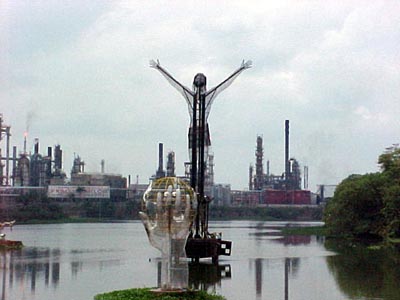 |
|
The
Cristo Petrolero, or Christ of the Oilfields, rises out of the
swamp next to Barrancabermeja’s refinery.
|
Ms. Becerra
heads the Popular Women’s Organization (OFP), a group that provides
food, health services, job training, and legal aid through "women’s
houses" (casas de la mujer) in the working class
neighborhoods of Barrancabermeja, the main city in the Magdalena Medio
region of central Colombia. She looks tired, like she has not had
a good night’s sleep in quite a while. I doubt she has, because
the OFP has faced the worst of the paramilitaries’ brutal campaign
to clear away the remnants of the city’s once-vibrant civil society.
Barrancabermeja
is hard to pronounce, and very little of last year’s billion-dollar
package of U.S. military aid for Colombia will end up anywhere near
this city. But as Washington edges closer to Colombia’s long,
bloody conflict, "Barranca" offers a preview of the nightmare
to come. For the first time here, the war is entering a scary new
phase of urban fighting that may soon appear in Colombia’s larger
cities. It is being spearheaded by the paramilitaries, whose growing
power the United States can no longer afford to ignore. The only force
left standing in their way is a beleaguered but outspoken group of
independent, non-violent human rights groups and community leaders
like Ms. Becerra.
An "outlaw
city"
Put together,
the Spanish words "barranca" and "bermeja" mean
"reddish-colored ravine." I did not see any such natural
highlights during CIP’s March 6-8 trip there. But what one can
see, from almost everywhere one stands, is a massive oil refinery,
its 200-foot flare stacks belching flame and thick smoke twenty-four
hours a day. Sulfurous smells and industrial-sounding noises can be
perceived from a mile away.
Today,
about three-quarters of Colombia’s fuel comes from Barrancabermeja,
making it a strategically crucial city. Add its central location along
the country’s main roads, its port with access to the Atlantic,
the nearby presence of gold and mineral wealth, and its position along
drug-transit routes, and it becomes clear why Barrancabermeja would
be a difficult place for a country to govern while at war with itself.
Barranca
was considered an "outlaw city" well before today’s
guerrilla and paramilitary groups came on the scene. In 1916, when
the first oil well was drilled, it was a small fishing port on the
Magdalena River, Colombia’s 965-mile-long equivalent of the Mississippi.
But oil made this stiflingly hot settlement a boomtown for decades,
attracting thousands of job-seekers. Until about the 1950s, male oil
workers made up most of Barranca’s population, and many of the
few women were prostitutes brought in from all over the world.
People
kept coming, lured by the promise of jobs and forced out of the countryside
by violence. The  town’s
population exploded from 15,400 in the 1938 census to about 300,000
today. More than 80 percent of the city was formed by "land invasions"
– squatters’ settlements, basically – which evolved
into working-class neighborhoods on the eastern side of town, away
from the riverfront. The names of many neighborhoods are simply dates
(20 de enero, 25 de agosto, etc.), indicating the anniversaries of
their original "invasions." town’s
population exploded from 15,400 in the 1938 census to about 300,000
today. More than 80 percent of the city was formed by "land invasions"
– squatters’ settlements, basically – which evolved
into working-class neighborhoods on the eastern side of town, away
from the riverfront. The names of many neighborhoods are simply dates
(20 de enero, 25 de agosto, etc.), indicating the anniversaries of
their original "invasions."
Like
fast-growing industrial cities anywhere, Barrancabermeja has long
been a hotbed of labor activism, radical populist politics, corruption
and violence. Oil workers formed what is still one of the country’s
largest and most powerful labor unions (the Unión Sindical Obrera,
or USO), which over the years has lost dozens of its leaders and militants
to violence, much of it state-sponsored. Newly invaded neighborhoods
organized to press the government for basic services, often inviting
a harsh response. Repression in turn fed the development of sophisticated
local human rights organizations.
Inevitably,
this mix of strategic importance, ungovernability and leftist political
leanings attracted 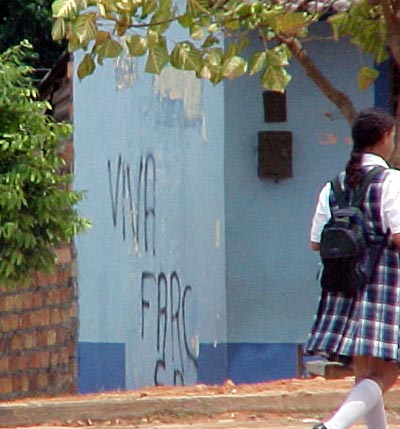 Colombia’s
guerrilla groups. By the early 1970s the city was a stronghold of
the National Liberation Army (ELN), the country’s second-largest
Marxist guerrilla organization, whose urban militias held sway in
the eastern slums. The larger Colombian Revolutionary Armed Forces
(FARC) arrived in the early 1990s, and a tiny third group, the vestigial
Popular Liberation Army (EPL), has also exercised influence. A visitor
can read slogans for all three spray-painted on walls throughout the
city, a rare sight in central Bogotá or Medellín. Abandoned by the
Colombian government, most residents of Barranca’s guerrilla-controlled
neighborhoods developed a live-and-let live approach, allowing the
leftist groups to operate in the open, paying "taxes" on
demand, and providing assistance when asked or forced to do so. Colombia’s
guerrilla groups. By the early 1970s the city was a stronghold of
the National Liberation Army (ELN), the country’s second-largest
Marxist guerrilla organization, whose urban militias held sway in
the eastern slums. The larger Colombian Revolutionary Armed Forces
(FARC) arrived in the early 1990s, and a tiny third group, the vestigial
Popular Liberation Army (EPL), has also exercised influence. A visitor
can read slogans for all three spray-painted on walls throughout the
city, a rare sight in central Bogotá or Medellín. Abandoned by the
Colombian government, most residents of Barranca’s guerrilla-controlled
neighborhoods developed a live-and-let live approach, allowing the
leftist groups to operate in the open, paying "taxes" on
demand, and providing assistance when asked or forced to do so.
But the
guerrillas are just one entry on the city’s list of violent groups.
Major Agustín Rodríguez, a 34-year-old officer who commands the Colombian
Navy’s 61st Advanced Riverine Post, had a very long list. Maj.
Rodríguez – whose unit, which must patrol 300 miles of the Magdalena
River, is to my knowledge the only security force in the area that
receives U.S. assistance – told us about the ever-present guerrillas
and paramilitaries; the criminal gangs who operate freely; the narcotraffickers
who smuggle drugs made elsewhere and grow coca plants across the river
in southern Bolívar department, mainly in paramilitary-controlled
zones; a copper cartel that controls the products of the region’s
mines; and a gasoline cartel that steals up to a quarter of the refinery’s
product by punching holes in the pipeline, filling everything from
cans to tank trucks. Some refer to the pipeline as "the flute"
because of all the holes punched in it. Much of the gas cartel’s
product goes to the southern Bolívar coca fields, where it is used
in the process that turns the leaves into coca paste, and later cocaine.
The
paramilitaries’ quick conquest of the Magdalena Medio
Doodling visual aids on a piece of paper as he talked (my favorites
were the stick figures representing guerrillas and paramilitaries),
Maj. Rodríguez candidly acknowledged that the paramilitaries are right
now the strongest and the fastest growing of all the armed groups in
Barranca and the Magdalena Medio region. The United Self-Defense Groups
of Colombia (AUC), a gathering of anti-guerrilla militias privately
financed by landowners and narcotraffickers, clearly has the momentum
in Barranca and its environs. Headed by a 35-year-old former drug-cartel
associate named Carlos Castaño, the AUC now controls nearly all town
centers and many rural areas in all twenty-seven municipalities (counties)
of the Magdalena Medio.
The AUC’s
takeover happened very quickly. While rightist groups have been active
in the region since a death squad called Muerte a Secuestradores (MAS,
or "Death to Kidnappers") formed in 1981, these squads of
hit men did the guerrillas little damage during the 1980s, choosing
instead to target local civilian leaders, particularly labor organizers.
This began to change in the early 1990s, when local death squads were
integrated into a Colombian Navy intelligence network that killed
over 130 union officials, journalists, teachers, human rights defenders
and activists. [See
Human Rights Watch’s 1996 report, "Colombia’s Killer
Networks," on the Internet at www.hrw.org/reports/1996/killertoc.htm.]
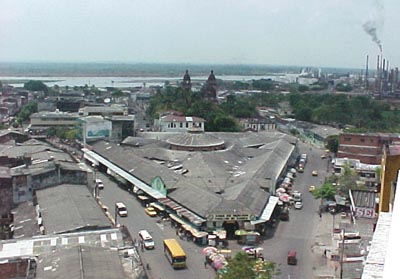 |
|
A
panorama of central Barrancabermeja. The Magdalena River is
in the background.
|
In 1993
the "paras" made the transition from hit-and-run death squads
to an occupying force, establishing their first permanent presence
in the Magdalena Medio region in the town of Puerto Boyacá. From there,
the newly formed AUC gained ground quickly through a strategy often
called "draining the sea to kill the fish" – a brutal
campaign of massacres, disappearances and forced displacement of the
civilian population. Paramilitary-controlled areas spread across the
map of the Magdalena Medio like a stain. Paramilitary terror in the
countryside sent a flood of refugees into Barrancabermeja,
swelling the city’s eastern zones and pushing the unemployment
rate to an estimated 50 percent by early 2001. By the end of the 1990s
the AUC had weakened the ELN so severely that paramilitaries controlled
even the guerrilla group’s mid-1960s birthplace in the San Lucas
Mountains of southern Bolívar department.
Colombian
and international human rights groups have thoroughly documented the
military support and toleration that eased the paramilitary takeover
of the Magdalena Medio. The relationship included the intelligence
networks of the early 1990s; sharing of information, weapons and ammunition;
failure to respond to paramilitary attacks and massacres; and willful
blindness to a very open AUC presence. The relationship continues
today; during our trip, CIP heard numerous complaints about activities
in the region around Barranca, including regular paramilitary checkpoints
100 meters from the 45th battalion’s headquarters across the
river in Yondó; paramilitary searches within 200 meters of the police
station in the port of Puerto Wilches, the next town downriver from
Barranca; and a regular 8 AM to 4 PM paramilitary river checkpoint
at a site called La Rompira, a few minutes north of Barranca, where
the paramilitaries kidnapped or disappeared eighteen people in 2000.
(The Navy told us that the paramilitaries do not maintain river checkpoints,
though on one recent occasion they found paramilitaries fleeing from
a site where one such roadblock had been reported.)
May
1998: The paramilitaries enter Barrancabermeja
By the
late 1990s, Barrancabermeja was the only population center in the
Magdalena Medio region without a permanent paramilitary presence.
In fact, the city was one of only a few breaks in a continuous band
of paramilitary control stretching across northern Colombia from Panama
in the west to Venezuela in the east.
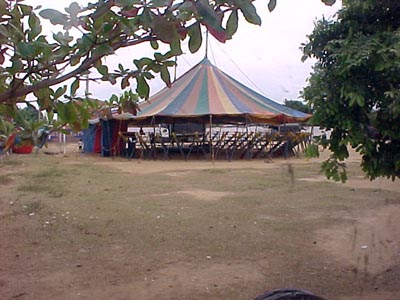 |
|
Civil-military
operation: Colombia’s Army has set up a circus on the site
of the 1998 massacre
|
The first
major paramilitary incursion in the city took place on May 16, 1998.
In one night of terror, paramilitaries swept through several of the
city’s eastern ELN-controlled neighborhoods, killing eleven people
and taking away another twenty-five whom they killed later. The 1998
massacre signaled the paramilitaries’ transition from selective
killings to full-scale military actions within Barrancabermeja’s
city limits. Many residents consider the May 1998 massacre a watershed
moment for control of the city; one human rights activist said that
Barranca’s history could be divided between a pre-1998 period
and a post-1998 period. [See
Amnesty International’s 1999 report, "Barrancabermeja: a
City under Siege," on the Internet at http://www.amnesty.org/ailib/aipub/1999/AMR/22303699.htm.]
After
May 1998, the AUC presence in Barranca slowly increased, as massacres
and other larger-scale activities became frighteningly common. For
a time, though, the paramilitaries focused more strongly on other
parts of Colombia (such as southern Bolívar department and the Catatumbo
region near Venezuela, where massacres took place almost daily in
1999). Though their incursions were more frequent, the AUC still lacked
the regular presence in Barrancabermeja that would make them a true
occupying force.
The
final paramilitary push into Barrancabermeja
This
began to change in April 2000, when a twenty-something deputy of Carlos
Castaño’s named "Julián" made a radio announcement
declaring his presence in Barranca and the AUC’s determination
to take over the city. A terrifying upsurge in violence followed;
in 2000, the government’s regional Human Rights Ombudsman’s
office reported, 539 people were killed in Barrancabermeja –
about 25 times the murder rate of New York City. Eighty-seven percent
were victims of the paramilitaries.
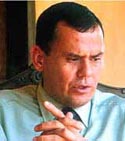 |
|
Carlos
Castaño
|
In late
December 2000, the paramilitary offensive began in earnest. Starting
in the east-central neighborhoods of Miraflores and Simón Bolívar,
more than 1,000 paramilitaries spread throughout the eastern half
of Barrancabermeja, and this time they stayed. Taking over neighborhood
after neighborhood, they gained control of most of the city in about
two months. When CIP staff came to visit in early March, only about
one and a half of the city’s seven "comunas," or wards
– essentially, just the downtown and the area around the oil
refinery – were outside of the AUC’s dominion. A frequently
repeated rumor was that Carlos Castaño himself had paid a brief visit
to Barranca’s formerly ELN-held northeast at the end of December,
fulfilling a boast that he would "have a cup of coffee"
there by New Year’s Day 2001.
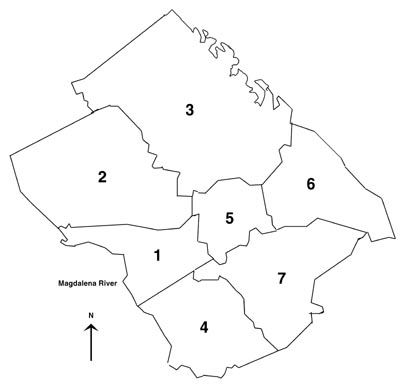 |
|
Barranca
and its comunas (wards): By most accounts, as of early March
the paramilitaries had taken all but comuna 2 and part of comuna
1
|
The paramilitary
offensive began immediately after a series of Colombian government
meetings with ELN leaders in Cuba. At these talks, the government
showed itself willing to ease negotiations by pulling security forces
temporarily out of two municipalities (counties) across the river
from Barrancabermeja. The municipalities, San Pablo and Cantagallo
in Bolívar department, had passed from ELN to paramilitary control
during the previous two years. While the government’s decision
was no doubt unpopular – a similar demilitarized zone granted
to the FARC has been the site of numerous abuses, with little progress
after two years of talks – the paramilitaries encouraged protests
against the zone (at times by force), including mid-February demonstrations
during which 13,000 protestors closed key roads for days.
So
far, the rule of what one human rights leader called "the new
masters of Barranca" has been exceedingly cruel. According to
the Technical Investigations Unit of Colombia’s Attorney-General’s
office, the AUC killed 145 people in Barranca during the first forty-five
days of 2001. Of these, estimates Ms. Becerra’s Popular Women’s
Organization (OFP), 15 percent were women.
In addition
to mass killing, the paramilitaries maintain control by closely supervising
all activity in their newly conquered neighborhoods. Residents of
the Barrio Kennedy sector, which was being used as a center of AUC
operations during CIP’s early March visit, are required to keep
their doors open day and night so that paramilitaries can enter and
leave at will. Paramilitary fighters are forcing some families out
of their homes (in Barrio Kennedy in February, they gave the families
a half-hour of prior notice), then using the houses as barracks and
headquarters. The paramilitaries have cut phone lines into several
neighborhoods, and they stop everyone in the street to interrogate
them about their destination and their business. Many people have
not left their neighborhoods in months. Because of Barranca’s
daily high-90-degree heat, people are accustomed to sitting and walking
outside in the cool of the evening – but in the paramilitary-controlled
neighborhoods, the frightened residents stay inside.
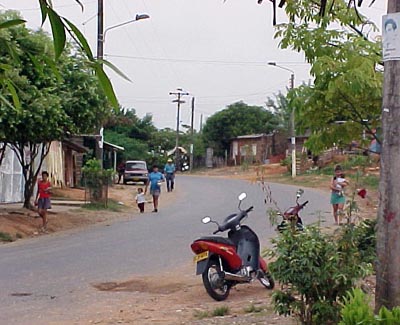
Local
human rights leaders told us that the paramilitaries are actively
recruiting 17- to 19-year-old boys, many of them veterans of the ELN
militias, and offering them a salary, one month’s pay up front,
a bicycle and perhaps a cell phone. The new recruits’ job is
to "clean" their neighborhoods of guerrilla supporters.
"While these boys may have been in the militias before, even
their own families fear them now," one community leader told
us. When these boys are no longer useful, we were told, the paramilitaries
kill them because they know too much – a practice called "erasing
information."
In
response to numerous calls for a government response, the security
forces have militarized parts of the city. Heavily armed soldiers
watched us from street corners, and we saw police mini-tanks parked
at the entrances to some conflictive neighborhoods. In January, Bogotá
pledged to send 1,000 Colombian Army special forces to keep order,
though the mayor, the bishop, and non-governmental organizations protested
that the deployment would only add to the violence. To date, only
eighty have arrived. January 12 marked the arrival in the city of
the so-called "Robocops" – an elite police unit easily
recognizable by their black uniforms, wrap-around sunglasses, and
wide array of weapons. The Robocops and other measures have made little
difference, though: between January 12 and early March, the number
of dead in the current paramilitary offensive tripled and the AUC
took over three of the city’s seven wards.
The presence
of police, however infrequent, in the "hot" neighborhoods
has not in the least bit hindered the paramilitaries. CIP President
Robert White and I saw plenty of them operating openly in Barrancabermeja’s
eastern neighborhoods during a tour organized by the Popular Women’s
Organization. Though they quickly removed their AUC armbands as our
bus entered neighborhoods like Barrio Kennedy, even the most clueless
gringo could identify the men wearing polo shirts, slacks and two
cell phones on their belts, standing idly on the sides of streets
lined with houses made of scrap wood, cinder blocks and corrugated
metal. The young men following us on motor-scooters and bicycles –
especially the angry-looking individual staring us down as he rode
circles around our slow-moving bus – were unmistakable. It was
clear who "the new masters of Barranca" were.
Looking
for explanations
How,
we found ourselves asking everyone we met, did they do it so fast?
Why did it take the paramilitaries little more than two months to
take over a longtime guerrilla stronghold?
The answer
we heard most often was not surprising, given the recent history of
the Magdalena Medio: the paramilitaries took over Barrancabermeja
so quickly thanks to the complicity and cooperation of Colombia’s
security forces. The AUC invasion began on December 23, coinciding
with a military operation known as "Operation Merry Christmas."
With the stated goal of guaranteeing a peaceful Christmas holiday,
military and police units set up a temporary presence in the entire
city. At the same time, hundreds of paramilitary fighters fanned out
into key neighborhoods. When the security forces withdrew, the paramilitaries
stayed behind, and the killings began.
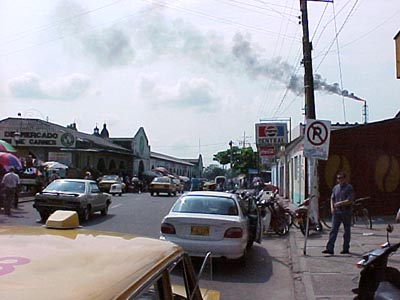 Though
fear has silenced most witnesses to military-paramilitary collaboration
during the current offensive, CIP heard numerous accounts of military
and paramilitary personnel operating separately but in full view of
each other, of police officers sharing cell phones with paramilitaries
and transporting them in their mini-tanks, and of paramilitaries being
warned well in advance of impending "raids" on their bases
of operations in the eastern neighborhoods. We heard an account of
police catching paramilitaries in the act of breaking into a house,
and instead of arresting them telling them to go away "because
it could cause trouble for us in Bogotá." We were told that while
a January 29 raid brought the arrests of fourteen paramilitaries,
eleven were inexplicably set free the following day. Though
fear has silenced most witnesses to military-paramilitary collaboration
during the current offensive, CIP heard numerous accounts of military
and paramilitary personnel operating separately but in full view of
each other, of police officers sharing cell phones with paramilitaries
and transporting them in their mini-tanks, and of paramilitaries being
warned well in advance of impending "raids" on their bases
of operations in the eastern neighborhoods. We heard an account of
police catching paramilitaries in the act of breaking into a house,
and instead of arresting them telling them to go away "because
it could cause trouble for us in Bogotá." We were told that while
a January 29 raid brought the arrests of fourteen paramilitaries,
eleven were inexplicably set free the following day.
While
the security forces’ cooperation made the paramilitaries’
rapid takeover possible, the guerrillas who controlled Barranca’s
working-class neighborhoods clearly played a role in their own defeat.
Pushed by threats or lured by the promise of higher pay, many members
of the ELN’s urban militias switched sides. These new AUC cadres
brought with them their lists of former guerrilla contacts, which
(along with the names of anyone else even rumored to be guerrilla
supporters) formed the hitlists for the paramilitaries’ killing
sprees.
The region’s
military commander, Fifth Brigade chief Gen. Martín Orlando Carreño,
places all the blame for the city’s takeover on the guerrillas.
"It’s all the guerrillas’ fault. They pushed the people
into the paramilitaries’ hands."
(Gen.
Carreño – whose predecessor at the Fifth Brigade was fired for
allowing paramilitary massacres in the Catatumbo region – is
a politically savvy officer and a likely future head of the military.
He is also a 1990 graduate of the School of the Americas’ year-long
Command and General Staff course.)
Certainly,
many of the city’s exhausted residents probably do welcome the
relative peace that comes with living in a zone under one group’s
undisputed control. César, my cab driver, was no exception. One evening
he accompanied me down to the riverbank near my hotel. Fishermen were
just loading up their long, narrow canoes for a night of casting nets,
and several people with trucks and wheelbarrows were shoveling river
sand through screens, hauling it away for construction material. Once
we were out of hearing, César stopped talking about fishing. "I
don’t support the paramilitaries and I don’t want to have
anything to do with them. But the ELN were abusing everyone in the
neighborhoods, and now that the paras are in charge things are better.
At least things are calm." This calm is only superficial, though;
Gen. Carreño noted that in many areas the paramilitaries are going
too far, mistreating the local population and winning only fear, not
support.
A
coming escalation?
The outlook
for the near future is even darker. By many accounts, the FARC and
ELN are teaming up for a counteroffensive, threatening a further escalation
in urban violence. Instead of responding 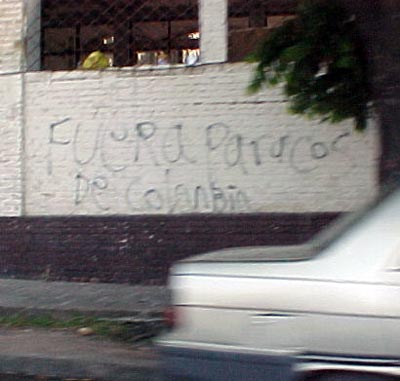 directly
to Plan Colombia in the southern department of Putumayo, many believe
that the FARC is shifting to other conflict zones like the Magdalena
Medio, a move that also gives the larger group an opportunity to fill
the vacuum left by the clearly declining ELN. During our visit we
heard reports of open firefights and house-to-house warfare on the
streets of Barranca’s eastern neighborhoods in the previous few
days, apparently between paramilitaries and the jointly operating
guerrillas. directly
to Plan Colombia in the southern department of Putumayo, many believe
that the FARC is shifting to other conflict zones like the Magdalena
Medio, a move that also gives the larger group an opportunity to fill
the vacuum left by the clearly declining ELN. During our visit we
heard reports of open firefights and house-to-house warfare on the
streets of Barranca’s eastern neighborhoods in the previous few
days, apparently between paramilitaries and the jointly operating
guerrillas.
Meanwhile,
across the river in southern Bolívar department, the Colombian army
was mounting a rare offensive. According to Gen. Carreño, the mission
of "Operation Bolívar" is to regain government control and
eliminate coca cultivation from the zone that may become the site
of the ELN peace negotiations. During the first four weeks of this
operation, ten U.S.-supplied Turbo Thrush spray aircraft fumigated
3,600 hectares (about 9,000 acres) of coca with the chemical glyphosate.
(These were the same spray planes used from December through February
for the first phase of the "Plan Colombia" offensive, far
to the south in Putumayo department.) Details about the operation’s
targets have been sketchy, though authorities claim that the paramilitaries
have been hardest hit by the military engagements and the fumigation.
Several times we heard mention of a January raid on a paramilitary
headquarters at San Blas, Bolívar department – though the paramilitaries,
obviously warned in advance, had abandoned the site well before the
raid. The ELN, which on March 9 broke off contacts with the Colombian
government to protest Operation Bolívar, apparently sees itself, and
not the paramilitaries, as the offensive’s main target.
Barranca’s
besieged community leaders
Amazingly,
despite its growing violence and bleak outlook, Barrancabermeja still
has a vibrant, outspoken civil society. After years of repression
and selective assassination, the remnant of Barranca’s labor
unions and popular movements remains mobilized and defiant.
Most
of the city’s neighborhood associations, women’s groups,
and human rights groups never had a friendly relationship with the
ELN. But at least, the Popular Women’s Organization (OFP) told
us, when they protested mistreatment the guerrillas generally left
them alone. "The ELN never liked us but they never blocked our
work," explained one of the group’s leaders.
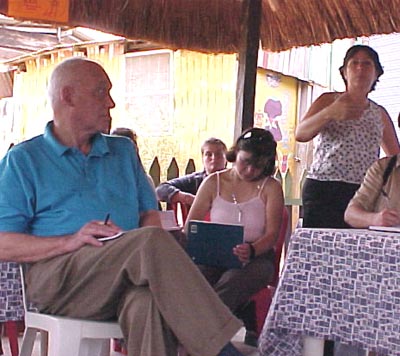 |
|
CIP
President Robert White with the OFP’s Matilde Vargas (standing)
|
Things
are far worse now. At this point, Barranca’s civil-society groups
are just about the only people the AUC does not control in the eastern
neighborhoods. Declaring them "military targets," the paramilitaries
are carrying out a campaign of constant threats and intimidation against
the few organizations that remain vocally opposed to them.
The entire
board of directors of the Regional Human Rights Committee (CREDHOS,
which has lost many members to selective killings) has been threatened
within the past few months; three have left Barranca since last September
and two have survived assassination attempts. The Association of Relatives
of the Disappeared (ASFADDES), which includes many families of victims
and witnesses of the May 1998 massacre, was forced to close its Barrancabermeja
office on February 28, 2001. The USO oil workers’ union has scaled
back its political activities in the last few months.
Government
agencies and international organizations have also faced paramilitary
aggression. The Colombian government’s Social Solidarity Network,
which provides aid to internally displaced persons, and regional Human
Rights Ombudsman’s office admit that they are largely unable
to work in Barrancabermeja’s eastern neighborhoods. On March
1, paramilitaries detained for hours and stole all supplies from an
international humanitarian mission delivering aid to a displaced community
in southern Bolívar department. The mission, with representatives
of the UN High Commissioner for Refugees, the World Food Program,
the government Human Rights Ombudsman, the Social Solidarity Network,
and the non-governmental Magdalena Medio Peace and Development Program,
was stopped for eight hours at a site only fifteen minutes from the
Colombian Army’s 45th Battalion headquarters.
Of all
agencies, Ms. Becerra’s OFP has been the most aggressively and
specifically targeted since the paramilitary takeover began. On January
27, paramilitaries paid two visits to the OFP’s "women’s
house" in southeastern Barrancabermeja, demanding that the house’s
director hand over the keys to the facility. This demand illustrates
the paramilitaries’ strategy, Ms. Becerra explained. The AUC
has no desire to shut down OFP’s food, health and other services,
which many of the neighborhood’s residents use regularly. Instead,
they want the OFP directors out of the way so that they can provide
the same services themselves – which is why they want the keys
to the "women’s houses." The second paramilitary visitor
to the OFP on January 27 was so belligerent that the police had to
come and arrest him. He was let go the following day.
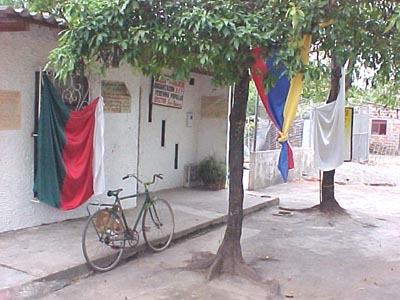 |
|
Paramilitaries
want the keys to the OFP “women’s house” (casa
de la mujer) in southeastern Barrancabermeja
|
Most
of Barrancabermeja’s human rights defenders go everywhere these
days in the company of foreign volunteers wearing T-shirts from Peace
Brigades International (PBI), a non-profit organization that provides
"accompaniment" to threatened activists in several countries.
PBI has a long and successful record of protecting dissident voices
in some very threatening situations. Several Barranca civil-society
leaders credit PBI’s European, Canadian and U.S. observers with
making their work possible during the current paramilitary onslaught.
"Without their accompaniment, I couldn’t visit the neighborhoods
where we work," said one. Another admitted that PBI volunteers
even accompany her to the bathroom when in the affected neighborhoods,
"because you never know when they might come for you."
Yet even
PBI is facing a serious challenge in Barrancabermeja. On February
8, two paramilitary thugs came back to the OFP’s southeastern
Barranca "women’s house" demanding the keys. They took
away the cell phone and passport of a Swedish Peace Brigades observer
accompanying the house’s staff, and declared both the house’s
director and the PBI worker "military targets."
Perhaps
cowed by the international outcry they triggered, the paramilitaries
appeared to shift their strategy in late February, directing their
threats at the OFP’s social base instead of its leadership. Seeking
to dry up the group’s support, the rightists are spreading word
that they will target all women who participate in OFP-sponsored events
and activities. The strategy seems to be working. Ms. Becerra told
me that on November 24, 2000, the OFP held a street march that attracted
10,000 participants. Now, because of the threats against the neighborhoods’
women, she doubts that she can convene a thousand.
|
Some
of Barrancabermeja’s best-known human rights defenders
The
Popular Women’s Organization (Organización Femenina
Popular, or OFP)
The
OFP, a support organization for Barrancabermeja’s working-class
women, was founded by the Catholic Church in 1972. It became
autonomous from the church in 1988 and in 1995 expanded its
work elsewhere in the Magdalena Medio region. The OFP offers
many services to the region’s women: economic aid (inexpensive
kitchens, cooperatives, training), education (scholarships,
publications and teaching materials), health services, youth
services (music and dance workshops), assistance to displaced
persons, and legal aid for victims of human rights violations.
The
Association of Relatives of the Disappeared (ASFADDES)
ASFADDES
is a support network for those whose family members have been
forcibly disappeared (over 4,600 people have been "disappeared"
in Colombia since 1982). ASFADDES offers legal assistance, documentation,
accompaniment, education and economic assistance. It fights
for verdicts against the perpetrators and reparations for the
victims’ families. The association has offices in the Colombian
cities of Bogotá, Bucaramanga, Popayán, Neiva, and Medellín.
Under relentless paramilitary harassment, ASFADDES closed its
Barrancabermeja office on February 28, 2001.
The
Regional Corporation for the Defense of Human Rights (CREDHOS)
Founded
in 1988, CREDHOS has a 25-member directorate and a membership
of 500 activists who work to defend the human rights of the
residents of Barrancabermeja and the Magdalena Medio region.
CREDHOS carries out human rights education projects throughout
the city, receives and investigates denunciations of human rights
abuses, and provides legal aid and technical assistance to victims
of violations.
Magdalena
Medio Peace and Development Program (PDPMM)
Founded
in 1995 by the Center for Research and Public Education (CINEP)
and the Diocese of Barrancabermeja, this highly regarded, large-scale
program carries out development and conflict-resolution projects
in some of the most troubled parts of the Magdalena Medio Region.
Peace
Brigades International (PBI)
Since
1994, PBI has maintained a program in Colombia to protect human
rights defenders and communities of displaced persons. Following
a strictly non-violent methodology, Peace Brigades workers physically
accompany threatened people and organizations, perform periodic
visits to conflict zones and meet regularly with local authorities
and non-governmental organizations. Currently, PBI volunteers
come from at least twelve countries in North America and Europe.
The organization operates in Bogotá, the Magdalena Medio region,
Medellín, and the Urabá region in northwestern Colombia. In
the Magdalena Medio, PBI volunteers accompany the OFP, CREDHOS,
and ASFADDES.
(Source:
Government of Colombia, Defensoría del Pueblo, Resolución Defensorial
No. 007 [Bogotá: March 6, 2001]).
|
During
our visit, it became obvious that the paramilitaries had not completely
given up their intimidation of OFP leaders. On March 7, AUC members
entered an eastern Barranca "women’s house" and destroyed
literature promoting an OFP event commemorating International Women’s
Day (March 8). Later that same day, while attending a gathering to
prepare for the March 8 event, Ms. Becerra got a call on her cell
phone from a stranger telling her to "get ready for what’s
coming."
Protecting
human rights defenders
What
can be done to protect Barranca’s battered human rights groups
in such awful circumstances? We asked the city’s new mayor, Julio
César Ardila, a former human rights ombudsman whose low-budget campaign
defeated the powerful Liberal Party machine largely by plastering
his campaign logo – a 1970s-style smiley-face – all over
town. Mayor Ardila argued that a permanent military presence throughout
the city would force out the paramilitaries and make conditions safe
for community leaders. "People don’t trust the security
forces here because they only come for a little while and then they
leave. They never stay." Gen. Carreño agreed with this criticism,
blaming it on scarce resources. He added that one of his main goals
is to increase permanent military deployments throughout the region.
When
I asked their opinion about this proposal, Barrancabermeja’s
human rights and community leaders disagreed emphatically. Some laughed
out loud. Given the history of military-paramilitary collaboration
that continues today, they argued, a further militarization of Barranca
would guarantee their extermination rather than protect them. They
do not see Colombia’s state as a potential protector.
The city’s
civil society groups believe that only international support can allow
them to do their work amid the current paramilitary offensive. Specifically,
they are asking for two types of help from non-Colombians.
First,
they contend that international pressure makes a huge difference.
Statements of concern, communiqués, responses to urgent-action requests,
and messages from the U.S. government (including members of Congress)
– any indications that the international community is watching
closely – have strong effects that are widely felt in Barrancabermeja.
Second,
the city’s human rights groups call for what they call "accompaniment"
– the physical presence of international allies alongside them,
at their events, in their offices, even on the street. While the PBI
presence is essential, we were told, the groups also need regular
visits from their allies in North America and Europe. Given the obvious
security risk, it would be irresponsible for the Center for International
Policy to recommend that individual U.S. citizens go to Barrancabermeja.
We nonetheless encourage our counterpart organizations in the United
States and Europe, who have the contacts and can take the precautions
necessary to minimize risk, to consider complying with the accompaniment
requests of the city’s human rights defenders, preferably coordinating
with their networks to guarantee maximum coverage. We also pass along
the Barrancabermeja human rights community’s expressions of gratitude
to Minnesota Sen. Paul Wellstone, who has visited the city twice,
in November 2000 and March 2001.
A
long-term approach, if political will exists
International
pressure and visits are not long-term solutions, though. Untying Barrancabermeja’s
tangle of violence and instability – preferably before its experience
is repeated in other, larger Colombian cities – will require
Colombians to take national-level action. The United States must also
be prepared to offer important assistance at key moments.
First
and foremost, Colombia’s government needs to do much more to
stop the paramilitaries. Colombians will not trust their state to
protect them until all can agree that the military-paramilitary relationship
has been decisively broken. This means arresting known paramilitary
leaders and responding quickly to attacks and threats. It also means
punishing security force personnel who aid and abet paramilitaries
or who knowingly allow abuses to occur. The United States, which has
entered into a very close partnership with Colombia’s security
forces, must apply heavy public and private pressure for a greater
anti-paramilitary effort. One under-utilized channel might be the
denial of U.S. visas to individuals credibly alleged to be financially
supporting the rightist groups.
Even
though it is frustrating and may take years, Colombia’s peace
process needs greater support because it offers a quicker way out
of the violence than an escalated war of attrition. From military
officers to human rights workers, everyone we met with expressed a
belief that the ELN guerrillas honestly desire peace. If the government
stands up to the paramilitaries and temporarily grants a demilitarized
zone across the river, it may pave the way for the smaller rebel group’s
graceful exit. It may also provide an instructive example for the
FARC about the viability of entering into serious negotiations.
Finally,
it is quite remarkable that everyone with whom we spoke – from
the brigade to the barrio – agreed that Colombia does not need
another massive package of military aid from Washington. Conflictive
zones like Barrancabermeja and the Magdalena Medio need social and
economic assistance. Development aid can alleviate the economic desperation
that feeds the conflict, and it can increase Colombian citizens’
confidence in their own government’s ability to deliver the goods.
This assistance must not be imposed from above – it must be designed
in coordination with the recipient communities, and it must avoid
inadvertently strengthening the paramilitaries, who are already promoting
their own plan for developing the Magdalena Medio region.
I asked
several people to respond to the U.S. government’s oft-repeated
argument that development projects cannot work by themselves until
military aid first provides security conditions. Major Rodríguez,
the naval officer, had the snappiest response. "We’ve been
trying to provide security conditions for thirty years and it hasn’t
worked. Development projects need to start now, even if we have to
start small. If the projects are successful, they will create support
among the population, who will then support the government. That’s
the best way to weaken the armed groups. More arms will not solve
the problem."
There
is nothing particularly new or innovative about these proposed solutions.
What has been lacking in Bogotá and Washington is the political will
to take the risks required for these old proposals to become reality.
We are still waiting for credible and far-reaching efforts to stop
the paramilitaries, unequivocal support for peace negotiations, and
economic assistance programs instead of dramatic military offensives.
While
we wait, the OFP and their colleagues keep trying to do their work.
On our tour of Barrancabermeja’s paramilitary-controlled eastern
neighborhoods, OFP leaders took us to one of the public kitchens where
they sell inexpensive meals to the locals. From this hilly zone the
flames of the refinery were easily visible, miles away next to the
river. A young man followed our group and stood outside the door,
sizing us up. Everyone stopped talking.
"Good
morning," an OFP leader addressed him, looking him in the eye.
"Good
morning," he replied.
A pause.
"Can I help you with something?"
"Are
you serving lunch yet?" (Nice try – it was just after 10
o’clock in the morning.)
"No.
Please come back later."
The paramilitary
watcher sidled off, further down the street. The OFP leader launched
into her lecture, as though nothing had happened.
The Center
for International Policy wishes to thank the CarEth and Compton Foundations
and the Stuart Mott Charitable Trust for the financial support that
made our visit possible. We also give our sincerest thanks to the United
Nations Development Program’s Barrancabermeja Office for offering
us so much advice and assistance.
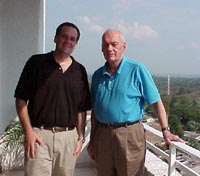 |
|
CIP
Senior Associate Adam Isacson (left) with CIP President Robert
White (right) in Barrancabermeja
|
Center
for International Policy
1755 Massachusetts Ave., NW, Suite 312
Washington, DC 20036
(202) 232-3317
Fax: (202) 232-3440
cip@ciponline.org
www.ciponline.org
A Publication of the Center for International Policy
©
Copyright 2001 by the Center for International Policy. All rights reserved.
Any material herein may be quoted without permission, with credit to
the Center for International Policy. The Center is a nonprofit educational
and research organization promoting a U.S. foreign policy based on international
cooperation, demilitarization and respect for basic human rights.
ISSN 0738-6508
|



 town’s
population exploded from 15,400 in the 1938 census to about 300,000
today. More than 80 percent of the city was formed by "land invasions"
– squatters’ settlements, basically – which evolved
into working-class neighborhoods on the eastern side of town, away
from the riverfront. The names of many neighborhoods are simply dates
(20 de enero, 25 de agosto, etc.), indicating the anniversaries of
their original "invasions."
town’s
population exploded from 15,400 in the 1938 census to about 300,000
today. More than 80 percent of the city was formed by "land invasions"
– squatters’ settlements, basically – which evolved
into working-class neighborhoods on the eastern side of town, away
from the riverfront. The names of many neighborhoods are simply dates
(20 de enero, 25 de agosto, etc.), indicating the anniversaries of
their original "invasions." Colombia’s
guerrilla groups. By the early 1970s the city was a stronghold of
the National Liberation Army (ELN), the country’s second-largest
Marxist guerrilla organization, whose urban militias held sway in
the eastern slums. The larger Colombian Revolutionary Armed Forces
(FARC) arrived in the early 1990s, and a tiny third group, the vestigial
Popular Liberation Army (EPL), has also exercised influence. A visitor
can read slogans for all three spray-painted on walls throughout the
city, a rare sight in central Bogotá or Medellín. Abandoned by the
Colombian government, most residents of Barranca’s guerrilla-controlled
neighborhoods developed a live-and-let live approach, allowing the
leftist groups to operate in the open, paying "taxes" on
demand, and providing assistance when asked or forced to do so.
Colombia’s
guerrilla groups. By the early 1970s the city was a stronghold of
the National Liberation Army (ELN), the country’s second-largest
Marxist guerrilla organization, whose urban militias held sway in
the eastern slums. The larger Colombian Revolutionary Armed Forces
(FARC) arrived in the early 1990s, and a tiny third group, the vestigial
Popular Liberation Army (EPL), has also exercised influence. A visitor
can read slogans for all three spray-painted on walls throughout the
city, a rare sight in central Bogotá or Medellín. Abandoned by the
Colombian government, most residents of Barranca’s guerrilla-controlled
neighborhoods developed a live-and-let live approach, allowing the
leftist groups to operate in the open, paying "taxes" on
demand, and providing assistance when asked or forced to do so.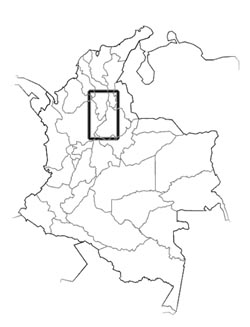
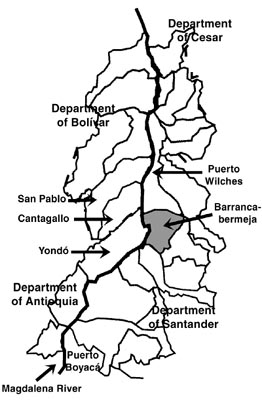





 Though
fear has silenced most witnesses to military-paramilitary collaboration
during the current offensive, CIP heard numerous accounts of military
and paramilitary personnel operating separately but in full view of
each other, of police officers sharing cell phones with paramilitaries
and transporting them in their mini-tanks, and of paramilitaries being
warned well in advance of impending "raids" on their bases
of operations in the eastern neighborhoods. We heard an account of
police catching paramilitaries in the act of breaking into a house,
and instead of arresting them telling them to go away "because
it could cause trouble for us in Bogotá." We were told that while
a January 29 raid brought the arrests of fourteen paramilitaries,
eleven were inexplicably set free the following day.
Though
fear has silenced most witnesses to military-paramilitary collaboration
during the current offensive, CIP heard numerous accounts of military
and paramilitary personnel operating separately but in full view of
each other, of police officers sharing cell phones with paramilitaries
and transporting them in their mini-tanks, and of paramilitaries being
warned well in advance of impending "raids" on their bases
of operations in the eastern neighborhoods. We heard an account of
police catching paramilitaries in the act of breaking into a house,
and instead of arresting them telling them to go away "because
it could cause trouble for us in Bogotá." We were told that while
a January 29 raid brought the arrests of fourteen paramilitaries,
eleven were inexplicably set free the following day. directly
to Plan Colombia in the southern department of Putumayo, many believe
that the FARC is shifting to other conflict zones like the Magdalena
Medio, a move that also gives the larger group an opportunity to fill
the vacuum left by the clearly declining ELN. During our visit we
heard reports of open firefights and house-to-house warfare on the
streets of Barranca’s eastern neighborhoods in the previous few
days, apparently between paramilitaries and the jointly operating
guerrillas.
directly
to Plan Colombia in the southern department of Putumayo, many believe
that the FARC is shifting to other conflict zones like the Magdalena
Medio, a move that also gives the larger group an opportunity to fill
the vacuum left by the clearly declining ELN. During our visit we
heard reports of open firefights and house-to-house warfare on the
streets of Barranca’s eastern neighborhoods in the previous few
days, apparently between paramilitaries and the jointly operating
guerrillas.

